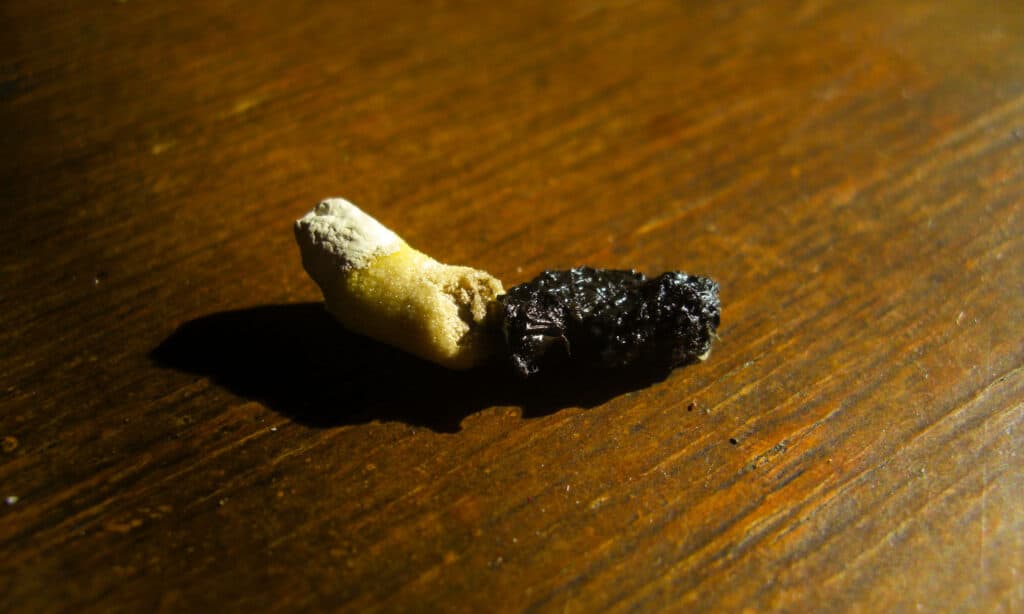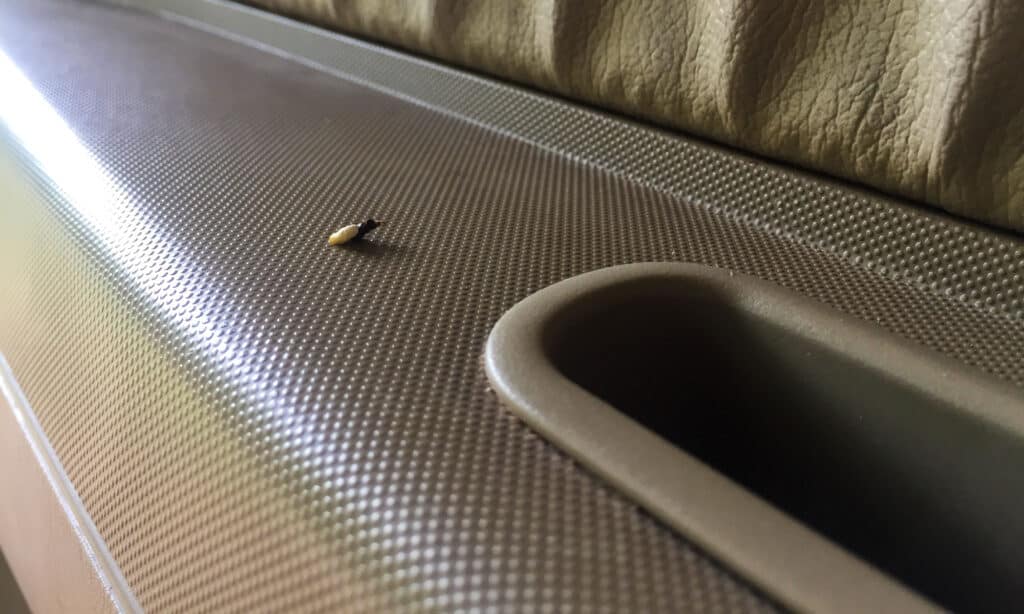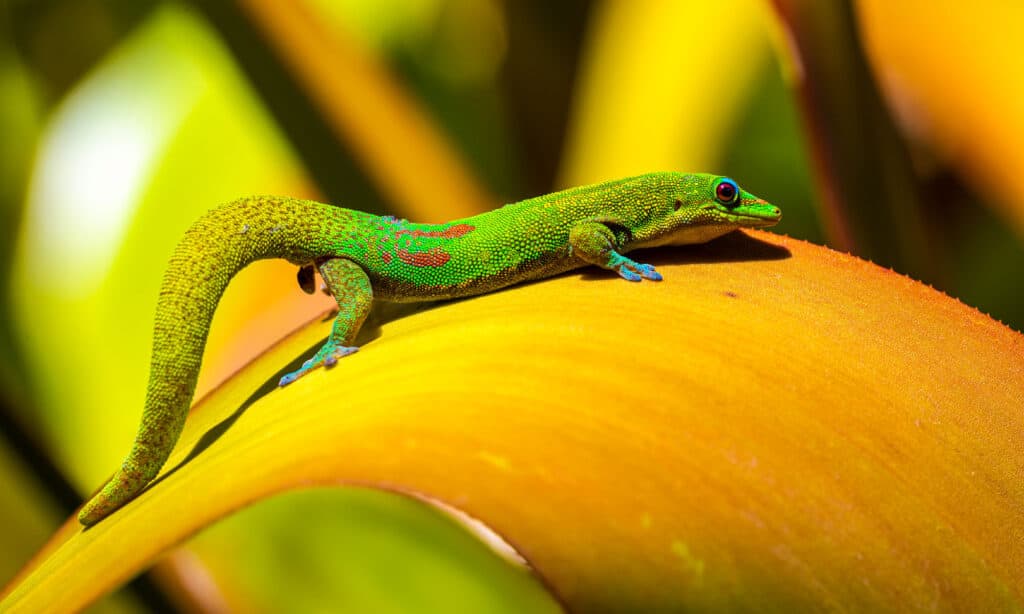Geckos are from the Gekkonidae family. These reptiles are nocturnal animals that you can find everywhere except in Antarctica. There are many intriguing facts about geckos and you will be surprised that some of them are related to their poop.
Interestingly, a gecko’s poop size, shape, color, and texture can reveal certain details about its diet, and health condition. Read on to learn everything you’ve ever wanted to know about the gecko’s poop.
What Does The Gecko Poop Look Like?

Gecko poop usually takes a cylindrical shape and is about 0.5 inches in length.
©Muhammad Akmal Juarsa/Shutterstock.com
Gecko poop consists of two different waste products; feces and urates. You might want to ask: why? Well, unlike mammals with two separate openings for urine and feces, geckos only have one opening; the cloaca. You might also want to ask: what differentiates feces from urates?
Feces is the solid waste passed from the intestines. Urates are solid waste too. However, they are a form of uric acid and that’s what differentiates them from feces. But unlike most animals with cloaca, geckos can pass out urates alone.
Gecko poop usually takes a cylindrical shape and is about 0.5 inches in length. Healthy poop is typically brown, but when it is passed out with urates, it would have some white color on it (that is because urates are white in color). Also, this reptile’s excreta has a solid texture. Soft poop could be a symptom of a change in diet or cryptosporidium disease.
But that is not all. The color of the poop can also tell so much about the health condition of the reptile. For instance, if the gecko passes out yellow poop, that signifies that it ingested too much fat. On the other hand, green excreta indicates that it ate a plant it is unable to digest.
Does Gecko Poop Smell?

If a gecko’s poop is infected with bacteria, it would smell.
©Artikom jumpamoon/Shutterstock.com
Interestingly, gecko poop is odorless. However, if the poop is infected with bacteria, it would smell. So, if you keep a gecko as a pet, it is advised that you clean its habitat regularly to prevent bacteria from contaminating its poop.
Do Geckos Poop A Lot?
How often a gecko passes out digestive waste is affected by its age and the amount of food consumed. Young geckos may poop several times a day. However, adults will typically poop only once in a few days. Additionally, when a gecko eats a lot, it poops more often than usual.
Gecko Poop Vs. Mouse Poop: What are the differences?
Gecko poop and mouse poop are similar because they have the same color. However, they have their differences. So what are they? While urates are found in gecko poop, they are blatantly absent in mouse poop. Unlike geckos, mice have a separate channel for urine. So their poop does not have traces of uric acid like that of geckos.
Another difference is the poop size. Mouse poop is generally smaller than gecko poop. Averagely, this rodent’s poop is about 0.25 inches in length whereas that of a gecko is about 0.5 inches.
Gecko Poop Vs. Rat Poop: What are the differences?
Gecko poop and rat poop are of very similar sizes but they still have their subtle differences. The first difference is their color. Rat poop is black and shiny, while gecko poop is brown with white pigmentation at one end.
Another difference is the shape. Rat poop is rounded at both ends giving it the shape of a coffee bean, while gecko poop looks like a small double-shaded cylinder.
Is Gecko Scat Harmful?
Gecko poop is harmful. Like most reptiles, bacteria can be found in gecko poop. Unfortunately, if humans ingest these bacteria, they can get sick.
Some of these bacteria include E.coli and Salmonella, which are commonly found in reptiles, amphibians, and birds. Therefore, if you own a gecko, care should be taken when cleaning its cage as you can contract this bacteria from touching its poop.
Is Gecko Poop Useful?
Gecko poop is more useful than you can imagine. Interestingly, these reptiles use their poop as a means of communication. They communicate by pooping systematically in specific areas as a keep-out sign for other geckos. Sometimes, geckos leave their waste as a form of boundary marking.
How Does The Gecko Poop?

The poop of a gecko is passed through their cloaca.
©Phillip B. Espinasse/Shutterstock.com
Geckos poop via their cloaca and their waste is discharged in the form of feces and urates. The digestive system of a gecko consists of the mouth, stomach, intestines, and vents. In geckos, digestion starts from the mouth, after it chews its food. From there, the food is passed into the stomach via the pharynx and esophagus.
When the stomach processes the food, it is passed through the small and large intestines for final digestion. The waste products are later stored in its vent. The vent consists of 3 areas:
- The coprodeum
- The urodeum
- The proctodeum
Solid waste products are stored in the coprodeum, while urine and egg/sperm are stored in the urodeum before they are passed through the cloaca.
What Do Geckos Eat?
Geckos are primarily carnivores; therefore, they feed on animals like crickets, spiders, small rodents, and grasshoppers. Interestingly, juvenile geckos and some species of gecko are omnivores. So they can eat both plant and animal matter.
Geckos are not picky about their food and would eat whatever is available to them in their environment. However, they prefer their prey alive and will typically not eat dead game.
How Many Types of Geckos Are There?

Many types of geckos make good pets, as long as you give them plenty of attention and enrichment.
©feri ferdinan/iStock / Getty Images Plus via Getty Images
There are over 1,500 species of geckos! There are six main families and they include the Eublepharidae, Gekkonidae, Diplodactylidae, Sphaerodactylidae, Phyllodactylidae, and Pygopodidae families.
Of these different types of geckos, some have become popular choices for pets due to their interesting behavior and colorful appearances. Some popular pet gecko species include the Leopard Gecko (Eublepharis macularius), Crested Gecko (Rhacodactylus ciliatus), Fat-tailed Gecko (Hemitheconyx caudicinctus) and Gargoyle Geckos (Rhacodactylus auriculatus).
Depending on the type of gecko, they can range in size from a few inches to over 2 feet. They come in various colors with patterns and a variety of shapes. Some geckos have sticky feet that allow them to climb walls and even ceilings, while others have claws that make them great climbers.
No matter what type of gecko you choose, they are all fascinating creatures that can make for amazing pets!
The photo featured at the top of this post is © Kurit afshen/Shutterstock.com
Thank you for reading! Have some feedback for us? Contact the AZ Animals editorial team.






